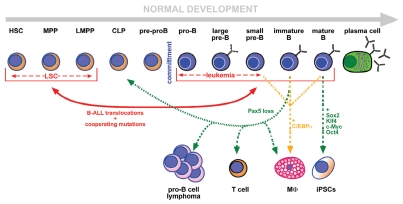Figure 1.
Plasticity in B-cell development. B-cell differentiation is represented in a lineal configuration representing the stages from the HSC to the terminally differentiated plasma cells (see text for details). Committed B cells expressing Pax5 are shown with a blue cytoplasm. The red lines represent events occurring during the genesis and evolution of B-ALL. The red continuous double arrow reflects the fact that dedifferentiation can occur from committed B cells to earlier developmental stages by the action of the oncogenic alterations, but, also, the presence of the leukemia-inducing alterations in stem/progenitor cells programs these cells to acquire a B cell-like phenotype. The dashed red arrows reflect the fact that both LSCs and differentiated B-ALL cells can present with a variable and evolving surface phenotype, resembling different developmental stages. Green and orange arrows represent situations obtained experimentally in vivo or in vitro, that illustrate the high degree of plasticity of B cells that allows them to give rise to either normal T cells, macrophages, to progenitor B-cell lymphomas or to induced pluripotent stem cells.

